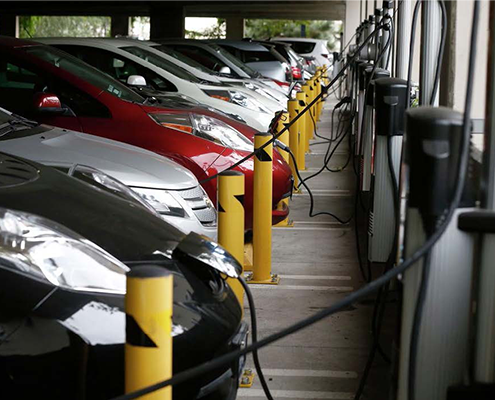Expanding Potential for Electric Vehicles in Apartments and Workplaces in Southern California
Mapping tool informs where investments can unlock latent demand for electric vehicles

Workplace and visitor parking at UC Irvine. Photo credit: Lucy Nicholson, Reuters.
June 9, 2021
While demand for electric vehicles is growing throughout Southern California, the lack of charging infrastructure in homes and workplaces often prevents residents from switching to electric. Using spatial data assembled by the UCLA Luskin Center for Innovation, cities can identify areas with unrealized demand for electric vehicles, and consequently reduce carbon emissions and local air pollution.
“By visualizing where to prioritize outreach, cities and counties can target their investments strategically,” said James Di Filippo, lead program manager for the Luskin Center for Innovation’s transportation initiative.
This data is available online through the Southern California Plug-in Electric Vehicle Atlas, an interactive mapping tool hosted by the Southern California Association of Governments. The atlas allows users to explore local factors that can help inform where charging stations are particularly needed.
“For consumers to continue to move toward zero-emission vehicles, it’s essential that we have the infrastructure to support that transition,” said SCAG Executive Director Kome Ajise. “This atlas is designed to make it easy and straightforward for local jurisdictions to make that happen.”
Now, an update to the Atlas allows users to add several data layers that estimate unmet demand for charging at multi-unit dwellings, such as apartments and condominiums, and workplaces — locations that often have high barriers to installing electric vehicle charging infrastructure.
Focusing investments in apartments and condos
In apartments, tenants often do not want to invest their own money to improve a property that they do not own, and landlords may be unwilling to install charging equipment if they do not see it as an amenity which can attract tenants or justify higher rents. These hurdles help explain why apartment residents are disproportionately underrepresented among new buyers of electric vehicles.
Updates to the tool allow users to identify which properties contain residents with a high likelihood to purchase an electric vehicle. From a cost-effectiveness perspective, investing in charging infrastructure where tenants are actually likely to use them will have the greatest impact.
At the same time, the tool also shows apartments and condos where community members may not be able to afford electric cars, but would benefit from access to these clean vehicles. From an equity perspective, concentrating investments in these areas can support communities that face the greatest economic barriers and suffer from the worst air pollution.
Strategically targeting workplaces
Barriers also exist in workplaces — often neither employees nor employers feel an impetus to install charging equipment. Without a place to charge, workers can be discouraged from buying an electric vehicle.
The tool now allows users to see which workplaces have high potential to benefit from charging equipment. If an employee is not able to charge their electric car at work, the clean-air capacity of their plug-in hybrid diminishes — these drivers often must rely on gasoline for part of their commute. The map allows users to view locations where this potential for electric vehicle charging is being underutilized. Further, users can overlap that information with the location of large employers, which have a high concentration of drivers. This can help enhance the likelihood that the chargers are used on a regular basis.
The latest additions to the Atlas were made possible through a grant from the Mobile Source Air Pollution Reduction Review Committee (MSRC), which funds projects that reduce pollutants from motor vehicles in the South Coast Air Basin. Along with the data layers described here, MSRC also funded a supplemental report that documents the methods for developing the data and their intended use.
Previous research by the Luskin Center for Innovation complements this spatial analysis by examining the financial considerations associated with installing charging infrastructure in apartment and workplace settings. Most recently, the Luskin Center for Innovation released a report on fast charging infrastructure, finding its potential to increase electric vehicle adoption by renters.


